译林牛津版高中英语选修9教案:u1 welcome to the unit
译林牛津版高中英语选修9教案:U1 Welcome to the unit
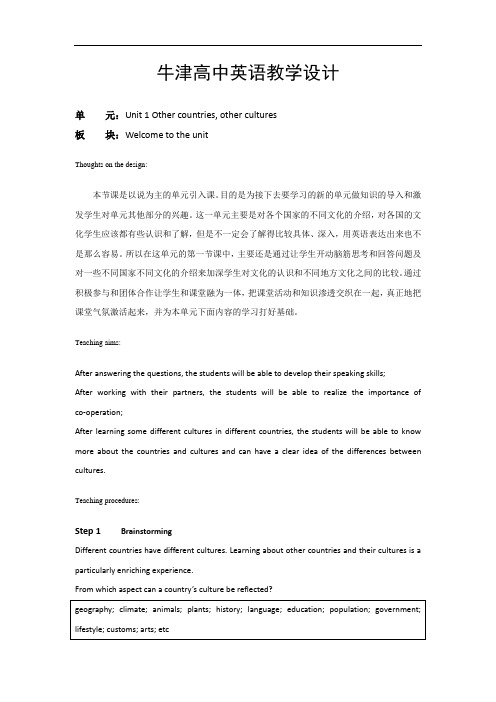
牛津高中英语教学设计单元:Unit 1 Other countries, other cultures板块:Welcome to the unitThoughts on the design:本节课是以说为主的单元引入课。
目的是为接下去要学习的新的单元做知识的导入和激发学生对单元其他部分的兴趣。
这一单元主要是对各个国家的不同文化的介绍,对各国的文化学生应该都有些认识和了解,但是不一定会了解得比较具体、深入,用英语表达出来也不是那么容易。
所以在这单元的第一节课中,主要还是通过让学生开动脑筋思考和回答问题及对一些不同国家不同文化的介绍来加深学生对文化的认识和不同地方文化之间的比较。
通过积极参与和团体合作让学生和课堂融为一体,把课堂活动和知识渗透交织在一起,真正地把课堂气氛激活起来,并为本单元下面内容的学习打好基础。
Teaching aims:After answering the questions, the students will be able to develop their speaking skills;After working with their partners, the students will be able to realize the importance of co-operation;After learning some different cultures in different countries, the students will be able to know more about the countries and cultures and can have a clear idea of the differences between cultures.Teaching procedures:Step 1 BrainstormingDifferent countries have different cultures. Learning about other countries and their cultures is a particularly enriching experience.From which aspect can a country’s culture be reflected?Can you find out which country does the following symbol represent? (Use the PPT to show the students the pictures one by one and ask them to answer the questions)[Explanation]这一步骤是为了活跃课堂气氛,激发学生的兴趣。
英语选修9译林牛津版unit2welcometotheunit教案

Unit 2 Witnessing timeWelcome to the unitTeaching aims and demands:1.To let students discuss historic sites and get them interested infamous historic sites.2.To practice students’ spoken EnglishDifficult and key points:1.To practise students’ spoken Englishs of historic sites.Teaching aids: multi- mediaTeaching steps:一.Brainstorming.1.Look at some pictures about some Chinese historic sites and saysomething about them and ask:1.What do you think of these pictures?2.Are they beautiful?2.Teacher gives students information about the pictures .3.Show students a picture of pyramids, then the pictures in the text.4.Ask students to search on the Internet or in reference books to getsome information about historic sites in the pictures.anize a class presentation by asking students to report theirfindings and show their pictures of the four historic sites to the class.6.Show students some information about the historic sites in thepictures二.Sharing information1. Ask one student to read the instructions to the class.2. Organize students to discuss the four pictures .Encourage students to use the information that they collected before class to discuss the four pictures.3 Organize students into small groups to discuss and try to find the answers to the questions:1.Which modern buildings do you think will be famous in 1000 years?2.What should we do to protect historic sites?anize the class into two groups, and have a debate:Should we rebuild historic sites that have been damaged or destroyed?5.Have students read the article in Part A on page 114 and the one in Part B on page 115 in Workbook三.Summary and homework.Read the article in Pare A on page 115 in Workbook。
牛津译林版-英语-九上--教案:6单元 Welcome to the unit

课题9A Unit 6 Welcome to the unit教学目标1.知识目标:了解与电视节目相关的词汇;了解电视节目的分类。
2.技能目标:学会用英语谈论喜欢或者不喜欢的电视节目类型并说出理由。
3.情感目标:学会怎样从压力中释放出来。
重点 1.知识目标:了解与电视节目相关的词汇;了解电视节目的分类。
2.技能目标:学会用英语谈论喜欢或者不喜欢的电视节目类型并说出理由。
难点学会用英语谈论喜欢或者不喜欢的电视节目类型并说出理由。
教学过程Step1:预习指导与检测Step2:展示目标Step3:课堂导学与互动任务一:Free talk任务二:W elcome to the unit学习A部分。
1、讨论:What types of TV p rogrammes do you know?2、根据课文第79页内容,回答问题。
3、独立完成课本第79页A部分的练习,全班核对答案。
学习B部分。
1、Listen and answer:2、将学生分成五人小组分角色朗读对话,组内就每个学生各自喜欢的电视节目进行询问和讨论。
3、请几名学生介绍他们组成员有关电视节目的喜好。
任务三:Comic strips1、Free talk2、听第78页comic strips回答问题:3、跟着录音朗读对话。
4、学生两人一组分角色朗读,请几对学生表演。
5、鼓励学生用自己的话复述该对话。
Step5:当堂反馈9A Unit 6 TV programmesWelcome to the unitSome questions:板书设计1) Is Eddie getting bored with staying at home all day?2) Why not?3) Does Hobo agree with Eddie?...Some Language points作业布置1. Remember the different TV programmes.2.Read the dialogues again and again.3.Make up a new dia logue about your favourite TV programmes.教学后记。
牛津译林版高中英语选修九Welcometotheunit

Like flowers can represent different things, each colour has a different meaning. What is brought into your mind when you see them?
red
green
yellow
pink
blue
black
golden
orange
What other colors do you know?
brown gray silver white yellow chocolate lemon cherry olive green sea green lime rose lavender
RED Orange Yellow Green
Blue
Purple White Golden Silver Black Pink
Picture Discussion:
Look at the four pictures on Page 33 and find out what the topic of each picture is.
Picture1: national flags Picture2: national flowers Picture3: masks in Chinese opera Picture4:different meanings of colours in the west and China
Each country has its own national flag with its own pattern and colors.
牛津译林英语9A u1l1 welcome to the unit 教案
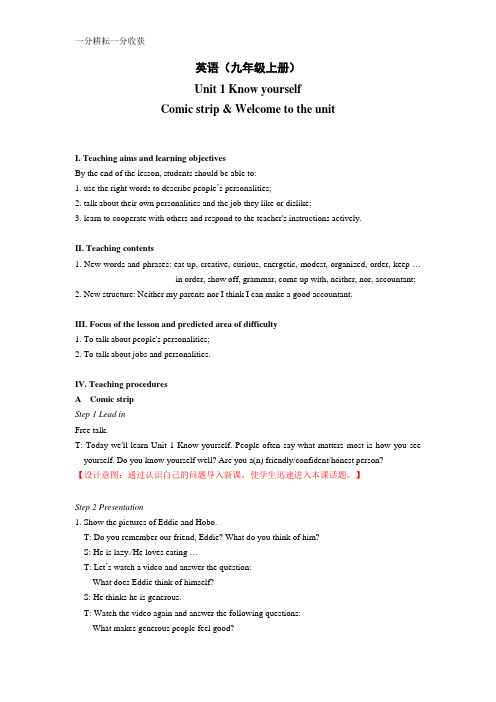
英语(九年级上册)Unit 1 Know yourselfComic strip & Welcome to the unitI. Teaching aims and learning objectivesBy the end of the lesson, students should be able to:1. use the right words to describe people’s personalities;2. talk about their own personalities and the job they like or dislike;3. learn to cooperate with others and respond to the teacher's instructions actively.II. Teaching contents1. New words and phrases: eat up, creative, curious, energetic, modest, organized, order, keep …in order, show off, grammar, come up with, neither, nor, accountant;2. New structure: Neither my parents nor I think I can make a good accountant.III. Focus of the lesson and predicted area of difficulty1. To talk about people's personalities;2. To talk about jobs and personalities.IV. Teaching proceduresA Comic stripStep 1 Lead inFree talk.T: Today we'll learn Unit 1 Know yourself. People often say what matters most is how you see yourself. Do you know yourself well? Are you a(n) friendly/confident/honest person?【设计意图:通过认识自己的问题导入新课,使学生迅速进入本课话题。
牛津译林版英语九上welcometotheunit教案
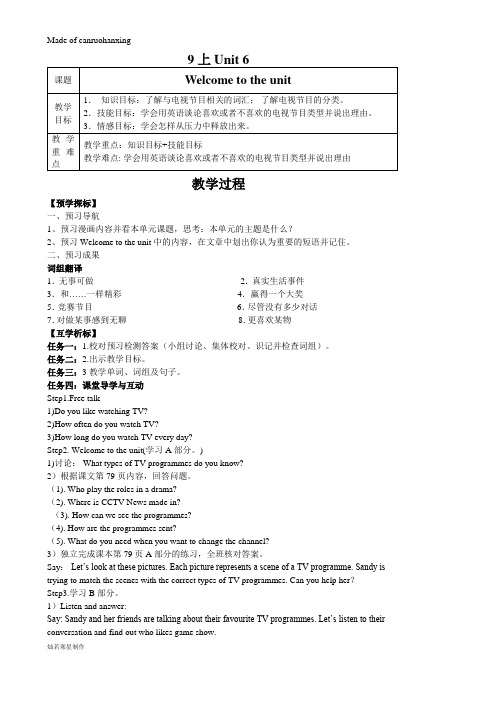
9上Unit 6课题Welcome to the unit教学目标1.知识目标:了解与电视节目相关的词汇;了解电视节目的分类。
2.技能目标:学会用英语谈论喜欢或者不喜欢的电视节目类型并说出理由。
3.情感目标:学会怎样从压力中释放出来。
教学重难点教学重点:知识目标+技能目标教学难点: 学会用英语谈论喜欢或者不喜欢的电视节目类型并说出理由教学过程【预学探标】一、预习导航1、预习漫画内容并看本单元课题,思考:本单元的主题是什么?2、预习Welcome to the unit中的内容,在文章中划出你认为重要的短语并记住。
二、预习成果词组翻译1.无事可做 ______________________________ 2.真实生活事件 ___________________ 3.和……一样精彩 _________________________ 4.赢得一个大奖 ___________________ 5.竞赛节目_______________________________ 6.尽管没有多少对话 ________________ 7.对做某事感到无聊 ______________________ 8.更喜欢某物 ______________________【互学析标】任务一:1.校对预习检测答案(小组讨论、集体校对、识记并检查词组)。
任务二:2.出示教学目标。
任务三:3教学单词、词组及句子。
任务四:课堂导学与互动Step1.Free talk1)Do you like watching TV?2)How often do you watch TV?3)How long do you watch TV every day?Step2. Welcome to the unit(学习A部分。
)1)讨论: What types of TV programmes do you know?2)根据课文第79页内容,回答问题。
译林牛津版高中英语选修9:U2Welcome to the unit完美版
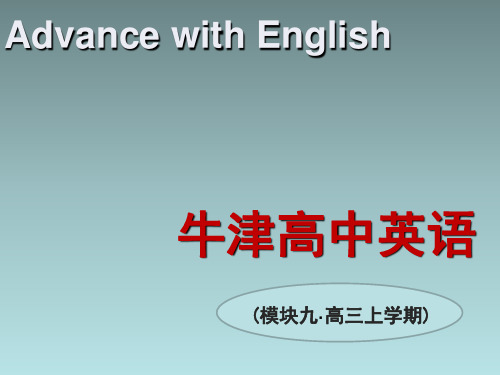
牛津高中英语
(模块九·高三上学期)
Unit
2
Witnessing time
Welcome to the unit
板块:教学设计——课件
Unit 2
课件描述:
这是本单元的第一课时,主要是利用 直观图片激发学生对本单元有关文化遗 址这一话题的兴趣。先了解国内的名胜 古迹,再拓展了解世界各地历史遗址的 相关信息。通过讨论等形式提高学生的 表达能力,激发学生保护世界文化遗产 的责任感。
Classical Gardens of Suzhou
Classical Gardens of Suzhou Angkor Wat
The Colosseum
St Brasil’s Cathedral
Step 2 Information exchange
Read the information on the paper in groups. Try to find out the following: • What is the Chinese name? • When and where was … built? • What was it used for? • Can you tell us more about it ?
2. Which modern buildings do you think will be famous in 1,000 years? Why do you think so?
Step 4 Homework
• Read a passage about more world heritage sites.
Can you tell us more about it? It was designed to hold 50,000 spectators.
译林牛津版英语选修九Unit1Welcome (共28张PPT)

1. "Every dog has its day." means"___D____".
A. Everybody in the world is lucky. B. Each person lives his own way of life. C. If one works hard, he's sure to succeed. D. Everybody has a time in life to be lucky.
Where is it? In New York, the USA.
Everything is bigger in this country, including the skyscrapers.
Other symbols?
the Statue of Liberty
the White House
Symbols of China
Tiananmen Square
The Great Wall
Shaolin Temple
Exercise for more information
1. Please read the following passage carefully and finish the exercise.
2. Check the answers:
第一段倒数1-2行: However, Chinese love cats very much. But in western culture, "cat" is often used to describe a woman who is cruel.
3. Which of the following is true according to the
高中英语选修 The written wordWelcome to the 教案译林牛津版
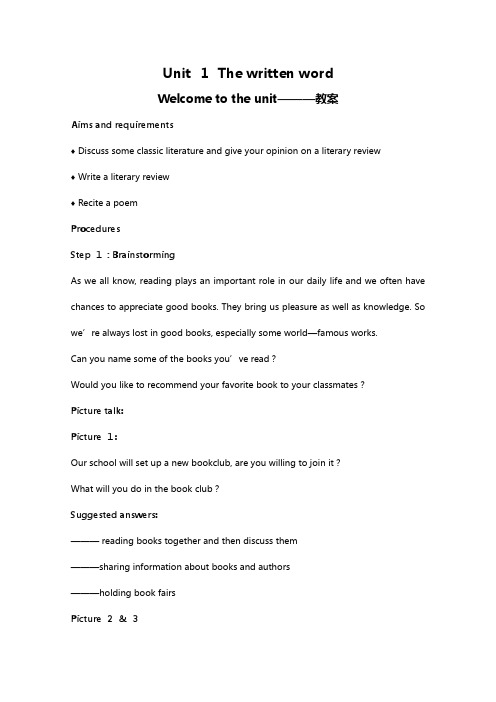
Unit 1The written wordWelcome to the unit———教案Aims and requirements♦ Discuss some classic literature and give your opinion on a literary review♦ Write a literary review♦ Recite a poemProceduresStep 1:BrainstormingAs we all know, reading plays an important role in our daily life and we often have chances to appreciate good books. They bring us pleasure as well as knowledge. So we’re always lost in good books, especially some world—famous works.Can you name some of the books you’ve read?Would you like to recommend your favorite book to your classmates?Picture talk:Picture 1:Our school will set up a new bookclub, are you willing to join it?What will you do in the book club?Suggested answers:——— reading books together and then discuss them———sharing information about books and authors———holding book fairsPicture 2& 3As students ,we can get close to all kinds of books. Among the following books which is your favourite?Or do you have another preference?As the development of technology, besides the traditional books, that is, books in print, do we have any other kinds of book?The e—books bring us a lot of convenience, now I’ll let every 2students as a group ,and the advantages of e—book?Suggested answers:1.Picyou can get the information you need immediately by downloading 2.E—Books are cheaper than paper books.3.E—books take up less space .4.E—books are portable and so you can carry it wherever you go.Also , I have a after—class thinking , that is ————the disadvantages of e—books. Picture 4Do you like reading or writing poems?Why or why not?Which poem is your favourite?Could you recite part of it for us?The definition of “ poem”PoetryPoetry is a popular art form, which emphasizes rhythm, sound and imagery. Poems usually use language set up in lines, with a regular rhythm and often a definite rhyme scheme. Poets usually express their strong feelings through this art form.Let’s appreciate a piece of poem and try to conclude the main idea of it.The most distant way in the worldThe most distant way in the worldis not the way from birth to the enD.it is when i sit near youthat you don't understand i love u.The most distant way in the worldis not that you're not sure i love u.It is when my love is bewildering the soulbut i can't speak it out.The most distant way in the worldis not that i can't say i love u.it is after looking into my heartI can't change my love.The most distant way in the worldis not that I'm loving u.it is in our lovewe are keeping between the distance.The most distant way in the worldis not the distance across us.it is when we're breaking through the way we deny the existence of love.So the most distant way in the worldis not in two distant trees.It is the same rooted branchescan't enjoy the co—existence.So the most distant way in the worldis not in the being separated branches.It is in the blinking starsthey can't burn the light.So the most distant way in the worldis not the burning stars.It is after the lightthey can't be seen from afar.So the most distant way in the worldis not the light that is fading away.it is the coincidence of usis not supposed for the love.So the most distant way in the worldis the love between the fish and birD.one is flying at the sky,the other is looking upon into the seA.Step 3:Homework1.Introduce a book to your frienD.Try to present it fully to him/ her.2.Preview Reading.。
英语选修九译林牛津U1同步课件(共26张)Welcome

What kind of images do we usually use to symbolize a country?
animal
person building
flower
costume
…
Which symbolizes the country best?
America
Which symbolizes the country best?
Unit1 Other countries,
other cultures
Welcome to the unit
南京九you ever been to England?
▪ geography ▪ history ▪ culture
(This picture is taken by Jiang shuang while visiting
Spain
Which symbolizes the country best?
Korean
Which symbolizes the country best?
New Zealand
Which symbolizes the country best?
China
Observation
▪ Who are the people in the picture?
If each picture represents one country in the world, which countries do you think of?
Why do you think that the images in these pictures represent those countries?
译林牛津版高中英语选修9:U1 Welcome to the unit全面版
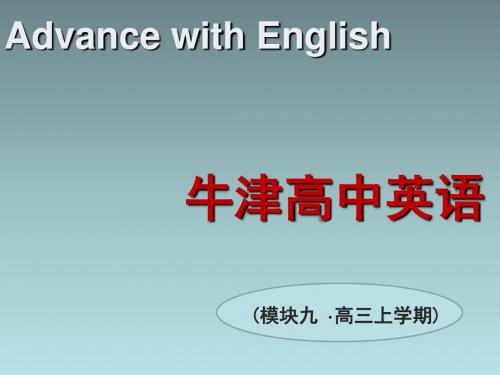
Unit 1
Can you find out which country does the following symbol represent?
Unit 1 What other things can you think of to represent Australia?
Koala
Great Barrier Reef (大堡礁)
Unit 1
Empire State Bui middle of Manhattan, Empire State Building is 102 stories high and visitors can see for 50 miles from the top.
Unit 1 What other things can you think of to represent the USA?
Statue of Liberty The White House
Unit 1
Can you choose a symbol to represent China? Can you say something about the symbol?
Advance with English
牛津高中英语
(模块九 ·高三上学期)
Unit 1
Welcome to the unit
Other countries, other cultures
板块:教学设计——课件
牛津译林版英语选修9讲义:Unit 4 Section Ⅰ Welcome to the unit
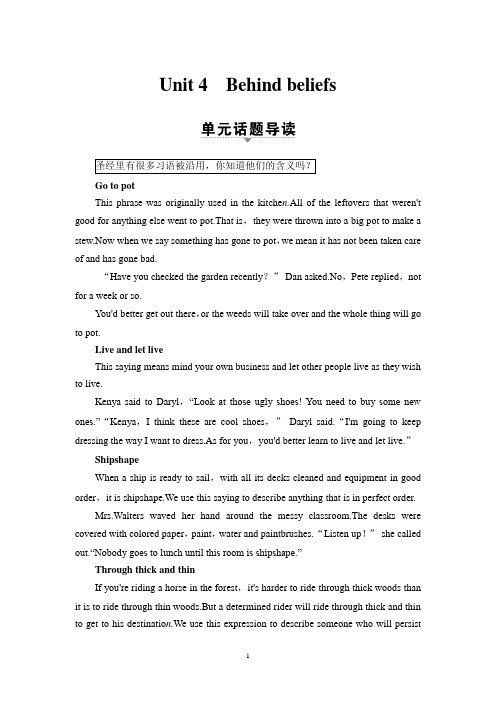
Unit 4Behind beliefsGo to potThis phrase was originally used in the kitche n.All of the leftovers that weren't good for anything else went to pot.That is,they were thrown into a big pot to make a stew.Now when we say something has gone to pot,we mean it has not been taken care of and has gone bad.“Have you checked the garden recently?” Dan asked.No,Pete replied,not for a week or so.You'd better get out there,or the weeds will take over and the whole thing will go to pot.Live and let liveThis saying means mind your own business and let other people live as they wish to live.Kenya said to Daryl,“Look at those ugly shoes! You need to buy some new ones.”“Kenya,I think these are cool shoes,”Daryl said.“I'm going to keep dressing the way I want to dress.As for you,you'd better learn to live and let live.”ShipshapeWhen a ship is ready to sail,with all its decks cleaned and equipment in good order,it is shipshape.We use this saying to describe anything that is in perfect order.Mrs.Walters waved her hand around the messy classroom.The desks were covered with colored paper,paint,water and paintbrushes.“Listen up!” she called out.“Nobody goes to lunch until this room is shipshape.”Through thick and thinIf you're riding a horse in the forest,it's harder to ride through thick woods than it is to ride through thin woods.But a determined rider will ride through thick and thin to get to his destinatio n.We use this expression to describe someone who will persistthrough good times and bad.“Maleek and I are best friends,” Dwayne explained,“He's stuck with me through thick and thi n.”1.What did Dan hope Pete to do according to the text?____________________________________________________________________________________________________________________2.Which phrase do you use if you want to express the meaning that you support someone,even in difficult situations?__________________________________________________________【答案】 1.To take care of the garde n.2.Through thick and thi n.Section ⅠWelcome to the unit & Reading—Preparing词义搭配1.straightforward A.not covered by any clothes2.vague B.easily damaged or broken3.underline C.to become ripe;to make sth.ripe4.bare D.easy to do or to understand;not complicated5.strike E.to hit sb./sth. hard or with force6.sow F.to plant or spread seeds in or on the ground 7.ripen G.not clear in a person's mind8.delicate H.to draw a line under a word,sentence etc.【答案】 1.D 2.G 3.H 4.A 5.E 6.F7.C 8.B。
2019年英语新同步译林选修九(江苏专用)讲义:Unit 1 Section Ⅰ Welcome
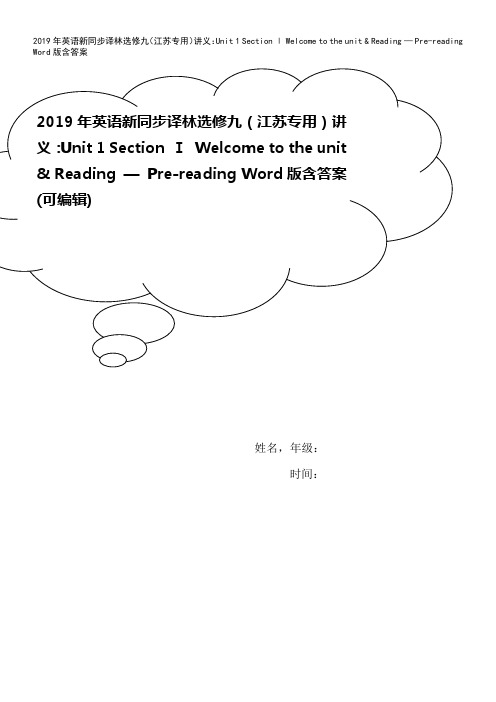
姓名,年级:时间:Section_ⅠWelcome_to_the_unit_&_Reading_—_Pre。
reading1.Why was it difficult for English speakers to travel in the Bavarian Forest National Park?2.What does the “Buggy Friendly walks” refer to?Please read the passage and try to find the answer.Germany is a great place for those who love walking in the most beautiful environment of nature。
There are many forests and beautiful natural places to relax in Germany。
One of the best places to visit is the Bavarian Forest National Park, which has a large number of paths and forest roads for visitors to choose from。
Some years ago, it was hard for English speakers to travel in this park between Germany and the Czech Republic, because it was hardly covered in Englishlanguage guidebooks (旅行指南).However, Bavarian Forest Holidays have now begun to introduce their own English language guides to help visitors make the most of their trip.Each guide is divided into different groups suitable for families with younger children and older travelers.There is even a lot of “Buggy Friendly Walks”, which spread out from a centralstarting point, and are suitable for people using wheelchairs。
- 1、下载文档前请自行甄别文档内容的完整性,平台不提供额外的编辑、内容补充、找答案等附加服务。
- 2、"仅部分预览"的文档,不可在线预览部分如存在完整性等问题,可反馈申请退款(可完整预览的文档不适用该条件!)。
- 3、如文档侵犯您的权益,请联系客服反馈,我们会尽快为您处理(人工客服工作时间:9:00-18:30)。
牛津高中英语教学设计
单元:Unit 1 Other countries, other cultures
板块:Welcome to the unit
Thoughts on the design:
本节课是以说为主的单元引入课。
目的是为接下去要学习的新的单元做知识的导入和激发学生对单元其他部分的兴趣。
这一单元主要是对各个国家的不同文化的介绍,对各国的文化学生应该都有些认识和了解,但是不一定会了解得比较具体、深入,用英语表达出来也不是那么容易。
所以在这单元的第一节课中,主要还是通过让学生开动脑筋思考和回答问题及对一些不同国家不同文化的介绍来加深学生对文化的认识和不同地方文化之间的比较。
通过积极参与和团体合作让学生和课堂融为一体,把课堂活动和知识渗透交织在一起,真正地把课堂气氛激活起来,并为本单元下面内容的学习打好基础。
Teaching aims:
After answering the questions, the students will be able to develop their speaking skills;
After working with their partners, the students will be able to realize the importance of co-operation;
After learning some different cultures in different countries, the students will be able to know more about the countries and cultures and can have a clear idea of the differences between cultures.
Teaching procedures:
Step 1 Brainstorming
Different countries have different cultures. Learning about other countries and their cultures is a particularly enriching experience.
From which aspect can a country’s culture be reflected?
Can you find out which country does the following symbol represent? (Use the PPT to show the students the pictures one by one and ask them to answer the questions)
[Explanation]
这一步骤是为了活跃课堂气氛,激发学生的兴趣。
先从本单元的题目:Other Countries, Other Cultures 引出话题:各个国家的文化是不同的,什么可以代表这个国家的文化?让学生开动脑筋,积极思考。
再给出4幅图片,都是学生非常熟悉的有名的建筑或人物,同时也是能代表该国家文化的标志,通过让学生回答这些代表的归属地,让学生对此话题产生兴趣。
Step 2 Sharing information
What about the pictures on P1? Which country does each symbol on page
1 belong to? (Use the PPT to show the students the 4 pictures and at the same time, ask them the following questions)
Picture 1
Who are the men in picture one?
Do you know something more about them?
What other things can you think of to represent Canada?
Picture 2
Who is the man in picture two?
What other things can you think of to represent the UK?。
